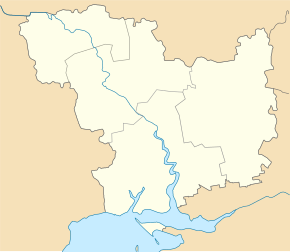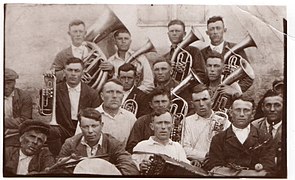Poritschtschja (Wesselynowe)
| Poritschtschja | ||
| Поріччя | ||

|
|
|
| Basic data | ||
|---|---|---|
| Oblast : | Mykolaiv Oblast | |
| Rajon : | Wesselynowe district | |
| Height : | 19 m | |
| Area : | 2.071 km² | |
| Residents : | 746 (2001) | |
| Population density : | 360 inhabitants per km² | |
| Postcodes : | 57013 | |
| Area code : | +380 5163 | |
| Geographic location : | 47 ° 23 ' N , 31 ° 8' E | |
| KOATUU : | 4821784201 | |
| Administrative structure : | 2 villages | |
| Address: | вул. Леніна буд. 11 57013 с. Поріччя |
|
| Website : | City council website | |
| Statistical information | ||
|
|
||
Poritschtschja ( Ukrainian Поріччя ; Russian Поречье Poretschje , until 1944 German Rastadt / Rastatt ) is a village in the west of the Ukrainian Oblast Mykolaiv with about 750 inhabitants (2001). Poritschtschja lies on the bank of the Chichyklija River ( Чичиклія ), a 156 km long right tributary of the Southern Bug and is the administrative center of the district municipality of the same name in the north of Vesselynove district , to which the village of Hradivka ( Градівка ) with about 500 inhabitants belongs.
history
The village was founded in 1809 together with the localities of Worms, Sulz , Karlsruhe and Munich as a settlement of German emigrants in the Beresan colony district. At the time of the complete evacuation by the German occupying forces around March 1944, its population was around 2,300 - a total of 529 families spread over 389 farms. Not counted here are the Jewish residents of Rastadt who were murdered by Einsatzgruppe D. In the period August / September 1941, 44 Jewish fellow citizens were murdered by the SS in Rastadt. In addition to the Jewish minority, there was also a Ukrainian minority in the village during the German settlement. The village school consisted of grades 1 to 8. It was taught in German before the Second World War. Ukrainian was the only foreign language offered. In the mid-1930s, German school classes 9th and 10th were set up in a school in Landau . From then on, some Rastadt students also took the opportunity to be taught in German in these higher classes. However, with the increasing state repression against the German population in the Soviet Union under Stalin , the offer was canceled after the completion of the first year in 1937 and grades 9th and 10th were set to German. Due to its location on the river, Rastadt was temporarily contested both in the Russian Civil War and in World War II . During the civil war there was a massacre of male rest towners by the Red Army as part of a retaliation against local rebel units . During the occupation of the village by the Wehrmacht in the summer of 1941 , two soldiers were killed by a mine. In the course of the fighting, the Red Army units, taken by surprise, had withdrawn to a wooded area outside the village and offered resistance from there.
Individual evidence
- ↑ a b local website on the official website of the Verkhovna Rada ; accessed on April 25, 2019 (Ukrainian)
- ↑ http://lmdr.de/wp-content/uploads/2012/04/blacksee.pdf Settlement of Germans in the Black Sea area (.pdf)
- ^ Raphael Böhler and Joh. Fröhlich: Rastadt settlement plan . Rastadt March 1944.
- ↑ П. Н. Шамрай: Судьбы евреев Николаевщины в период Великой Отечественной Войны 1941–1945 гг. . Ed .: П. Н. Амрай. Николаев 2012, ISBN 978-6-17680002-6 , p. 66 .






